Duke Energy, Southern Co., Dominion
Steve Mitnick is Editor-in-Chief of Public Utilities Fortnightly and author of the book “Lines Down: How We Pay, Use, Value Grid Electricity Amid the Storm.”
Jan Vrins is the global Energy practice leader at Navigant.
The chief financial officers of the three large southeast utilities (Dominion, Duke Energy and Southern Company) sat down with PUF editor-in-chief Steve Mitnick and Navigant Energy practice leader Jan Vrins to answer questions. In this fascinating discussion, they demonstrate overall strategy is just as important in their work as the traditional number-crunching of a utility's financial leader. Part One of the discussion follows. Look for Part Two in August 2017’s Public Utilities Fortnightly.
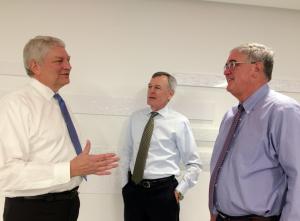
PUF's Steve Mitnick: What is your aspiration for where your company will be five years from now?
Duke Energy's Steve Young: We have to engage with our customers in a very different way. We have to be a true partner in how they efficiently and effectively use our product and our energy. We are at a point where technology enables us to interact differently. Our customers are interfacing with Amazon, Google, and Apple, and they expect different things from us.
Our industry's been based on building generation plants. Now, we have to develop a different set of assets, the grid, and deal with our customers in a different fashion. I think it's going to be a more customer-focused, more grid-oriented business than what we've traditionally seen in the past.
Dominion's Mark McGettrick: Dominion will focus on several areas. First, to continue to be able to provide industry-leading shareholder returns, as we have in the past, including having one of the top dividend growth rates in the industry.
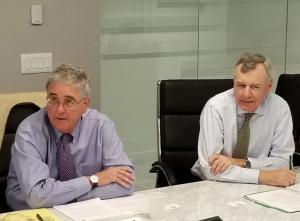
Second, we have a little bit different structure than most of the utilities in the country. We have a Master Limited Partnership and a parent company.
We are using this tax advantaged structure as a financing vehicle for the parent. We will optimize our balance sheet by reducing debt, increasing dividends, supporting capital growth and repurchasing shares.
Third, we have to strengthen our balance sheet. Like a lot of the companies in the country, we have levered up our balance sheet to grow over the past decade, taking advantage of very low financing costs. We will use a significant amount of cash flow from our business to de-lever our balance sheet, which is quite important.
Fourth, we want to continue to improve the company's safety performance. Although we've made great strides over the past several years, we're not at zero accidents yet. We'll always continue to have a goal to improve safety year-over-year, no matter what our performance was the previous year.
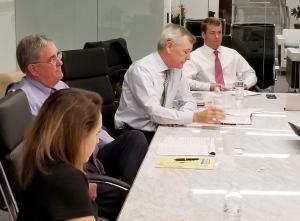
Finally, we have to, as an industry and as a company, maintain our focus on sustainability and the environment. Everyone's doing a lot. It's an area not fully appreciated by the public.
I know all the companies in this industry are very environmentally conscious. We need to continue to talk about that over the next five years, and articulate with outside parties the leadership role we have and will take on the environment.
Southern Company's Art Beattie: When we look at the next five years, we mainly focus on principles. Principles that have served us well to get us where we are today. That begins with the fundamentals. Making sure our customers are well served. That we provide them clean, safe, affordable, reliable energy.
We think that's a standard that won't change over the coming years. People are using energy in a different way and we're having to adapt to those changing needs. Either the way we bill them or the way we serve them, and the way we communicate with them.
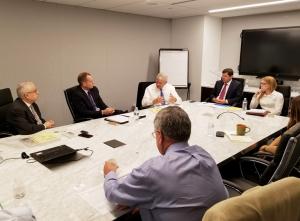
But when you think about how we do it, it's partnering within our communities. Being a citizen wherever we serve is one of the sayings that Preston Arkwright, the first president of Georgia Power, developed ninety years ago. That serves us well in our regulated communities.
When I think about a CFO's role, we're responsible for the financial health of our companies. But we have to remember how we got there. We got there by satisfying our customers. If we can't satisfy our customers, it's unlikely we'll be able to have successful financial results in terms of our balance sheets, and in terms of our prospects for attracting capital into our business.
That's the balance that, as CFO's, we've got to remember. At Southern, we've got a number of other issues in the forefront of our scope, but an important aspect of that is energy innovation.
How can we create innovation within our workforce to adapt to the changing world? Those are the key kind of fundamentals that we work for over the next five years.
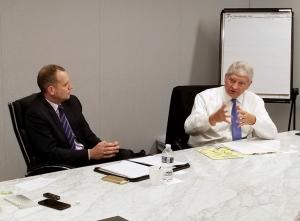
PUF's Steve Mitnick: You talked about the customer focus. There's probably a lot of work behind that?
Duke Energy's Steve Young: There is. We've always said, "Hey, we're customer focused." But I think - truly - we're at a point now where the technology does make a difference with what we can do with the customer.
Digital and technological breakthroughs allow so many more offerings. The expectations of our customers are tremendously advanced, compared to where they were in terms of billing options, information about consumption, information about outages, and the status of their situation in the power grid. Options for distributed generation and other capabilities. These things are technologically viable.
We've talked about them throughout my career, but they weren't really technically viable to provide. Now they are. So we have people on the ground setting up what is a viable innovative technology to provide for customers. They provide billing options, consumption options and knowledge, and updates about the status of the grid.
We have people studying that and trying to put those products and services in place. It's quite an advanced effort that we're putting in place to keep up with these demands. What's different, is that technologically we can provide different services to customers than we could at the beginning of my career.
Navigant's Jan Vrins (also a questioner): There's a lot of discussion about new energy products and services. How do you provide and integrate them?
Duke Energy's Steve Young: You can gather data in a number of ways, but what are you going to do with it? Do you have the people that can assimilate it and communicate it to the customer in the appropriate fashion? Can the customer use it? Can it help provide benefits on both sides of the equation?
That's where we've fallen short historically in the past. But we have infrastructure now, where we can provide customers with options for billing payments, and provide customers with options for electricity usage around their businesses or their homes. And all of this requires a combination of people, technological resources, and physical assets.
PUF's Steve Mitnick: A lot of customers are looking for more on sustainability. How do you approach that?
Dominion's Mark McGettrick: I think it's going to tie in with technological improvements down the road. But most of the companies are doing quite a bit in this area already. And the customers and public at large probably don't fully appreciate the positive actions the industry has taken.
We need to have a louder voice on sustainability, whether it be on solar, energy efficiency, weatherization, or carbon reduction, et cetera. If you look at the history of most of the companies, they will show a commitment to environmental stewardship and sustainability. Our voice has to get louder here.
We have to get better at communicating, and we have to continue to step up our efforts. Investors want us to do it. Customers want us to do it, and I think all the companies in the industry want to do it.
PUF's Steve Mitnick: Please talk about how partnering figures into this.
Southern Company's Art Beattie: The world's changing dramatically in a lot of different ways. In my era growing up, electricity was a commodity. You wanted kilowatt-hours, you got kilowatt-hours. We decided the cheapest way, along with our regulators, to deliver that. And it was like when Henry Ford said, "you can have any color car you want as long as it's black."
So now you've got more specifications being demanded. Sustainability being one of them. People want kilowatt-hours, but they want it from a particular source. So, it's becoming much more specialized.
How do you go from a commodity to a more specialized, "designer electron," so to speak? We need to be able to deliver to mostly industrial and commercial but also residential customers what they want. We're dealing with that in a regulated environment. But we're also dealing with it outside of that.
Last year we acquired a small company called PowerSecure that allows us to help companies beyond the meter who are interested in doing that.
We're still very much involved in the regulated central station power, generation, and grid modernization efforts. But we're also looking at the other side of the meter, and trying to give customers what they want. It's a way for us to put our foot in the water and test to see whether there's something there.
It's just amazing the way the world has changed, and the partnering that can go on in the name of sustainability, reliability or affordability. Whichever way it goes, we're going to have to start partnering with those companies in order to meet their needs.
Dominion's Mark McGettrick: The companies in this industry are not marketers typically. They're infrastructure companies, and they'll always be infrastructure companies.
So, the question is, how much advancement can you make, and where do you draw the line on enhancing the services you can provide? Are you going to go beyond the meter with products and services?
There will be some companies that try to take this approach. Other companies will rely more on their expertise in infrastructure to continue to support the needs of gas and electric customers.
Jan Vrins: Providing or even orchestrating those platforms on which those products and services are being provided, whether it's electrification of transportation, or energy management.
Dominion's Mark McGettrick: There's a wide spectrum in what you just described. You can do that at a certain level and provide those services to customers. Or you can do it at a different level, and then you're competing against a different set of providers.
I don't argue with that at all. But it's where are these companies going to fall in the spectrum - and they're going to be all over.
PUF's Steve Mitnick: From the perspective of the CFO, what are the most important challenges?
Duke Energy's Steve Young: A couple come to mind. One is the lack of organic load growth, the term we use for growth in the sales of electricity or basic products (even in the consumption of gas).
Particularly on the electric side, we see organic load growth around maybe one-half of one percent a year. That's very different than it was a generation ago, obviously.
That then leads to a very different model for growing the business. And it shifts away from generation assets that were so necessary when you saw five percent growth per year, to more of grid-oriented investments for reliability and customer interaction.
That brings me to the second challenge we face. If you're shifting to those types of investment opportunities, and you're facing a low load growth paradigm, then the regulatory recovery mechanisms are the next challenge. Because they've got to change.
The regulatory recovery mechanisms of base rate cases typically have been timed with the completion of a large generation plant, where it was generation-focused, and there was lots of load growth to carry it between these rate cases.
Now as we make smaller, but more numerous, incremental grid-type investments, or even smaller combustion turbine-type investments on the generation side, you've got to have more interaction with the regulatory bodies.
Redefining that construct to move towards grid mechanisms, unbundling, those types of things need to come into the forefront. Those are a couple of challenges that I see, sitting in my spot.
Dominion's Mark McGettrick: Most companies in this space say they're going to grow their earnings per share by four to eight percent annually.
That's a wide range. Some people are going to be able to do that, while some people won't. To me, the number one challenge in this area is how are you going to identify those growth opportunities to give you premium growth in the industry?
Our growth rate is six to eight percent. We feel good about that with the projects we've identified over the next three or four years. But what's going to happen in year five, in year six?
Gas infrastructure build-out in the country has been unbelievable. Is it going to slow down? Don't know. Generation is going to be a different mix for sure. It's not going to be as expensive as some previous options. So, a lot to pick from.
The second major challenge is the solar puzzle, whether it be generation solar or residential solar, the price points now have gotten to where they are somewhat competitive in the east. The midwest and west coast are dealing with this already. But the east coast is just in its infancy of understanding the issues.
As you try to meet that customer need, I think Dominion's probably been on the forefront of that on the east coast, mainly driven by data centers in the state of Virginia who have been very aggressive in solar installations. How are we going to match that customer need going forward and handle rate impacts along with that? Grid modernization will be critical to handling this new dispersed solar generation.
I think people underestimate still the speed at which solar is being developed. The grid itself is not designed to support this distributed type of solar generation.
With the advent of lower cost technology, you're going to have a lot of investment to adapt the grid to support a much higher level of renewables. That's going to put pressure on rates, which we're going to have to manage carefully.
PUF's Steve Mitnick: I thought being a CFO would be fun. It doesn't sound as much fun now.
Southern Company's Art Beattie: No, it is a challenge, but it is also a tremendous opportunity to better serve our customers. The way our customers are using energy is changing dramatically.
A lot of younger people are willing to move into multi-family homes, and they use less energy than a single-family home. Our commercial customers are reacting and picking off low-hanging fruit, either through their lighting or their HVAC system. They're taking advantage of bonus depreciation, low interest rates - all of that is driving a lot of their decision-making. It's impacting our sales numbers.
But the real challenge that I want to focus on is cost control. Because we've got to make sure that we manage our rates, and that's one of our most important principles going forward - affordable energy.
We can't get in the habit of going back to our regulators and saying, "well, our sales are zero, therefore, we've got to charge more." We've got to find a way to manage the cost increases to what's happening on the top line in addition to modernizing the grid. And helping make sure that those additional investments don't put undue pressure on our customers.
As I said at the get-go here, it's all about our customers. We've got to make sure we remember who they are, and who's paying the bill to make sure we've got reliable financial outcomes for all of our investors.
PUF's Steve Mitnick: Are there some good strategies out there?
Duke Energy's Steve Young: There are strategies. The three companies here have a great history of implementing strategies and responding to the changes that are in front of us.
When I think about the strategies that Duke is employing, there are a couple that we've put together. We have three core businesses that we're focused on. First, our electric infrastructure business - the strategy behind that is to enable our franchises to modernize the regulatory construct.
We have put forth stakeholder outreaches in our jurisdictions to discuss the types of investments that are going to make a difference to our customers. It's more grid-leaning than it has been in the past, so we talk about smart meters and storm-hardening equipment and targeted undergrounding.
A strategy here is to broadly discuss the benefits of these investments. This isn't just shifting to a new way of spending money to earn money. This is customer facing, and it has true benefits, so our strategy there is important for us.
When it comes to sustainability, we need to show how we are generating cleaner energy and making those efforts. That's another strategy we have.
We have a goal for a forty percent reduction in carbon output by 2030. We're at twenty-nine percent since 2005. That's our anchor year. We want to get to forty percent reduction from there.
So, we look for opportunities to retire our carbon-producing assets early, and replace them with renewables or natural gas-fired generation. It's typically coal that we're looking to retire early. We look for stakeholder involvement to make that happen, so it's not just a mandated thing.
We now have legislation in North Carolina to retire a coal plant early and build gas and renewables in its place. We had to work with stakeholders to pass legislation. You have to have stakeholder involvement. That's a way to decarbonize that shows involvement of everybody in the process.
A strategy related to these efforts is to generate cleaner energy.
Our final strategy is to develop natural gas infrastructure. That's a critical piece of the pie going forward.
Generally, the southeast is a bit "light" in terms of gas infrastructure, and gas is a lower-carbon alternative than coal. It's the remaining base load generation source that's available on the electric side, so we need to strategically communicate the value of and need for that infrastructure for both gas and electric businesses, and energy consumption as a whole, to take advantage of the technologies that bring natural gas pricing down. Those are some of the strategic efforts that are underway.
PUF's Steve Mitnick: All of your companies have been going into gas.
Dominion's Mark McGettrick: The best way to deal with some of the opportunities we've discussed and support future growth is to have a diversified portfolio. We have electric transmission, electric distribution, and electric generation.
We have gas distribution, and transmission. We have focused on diversification for decades. In any given period, you'll have peaks and valleys, growth opportunities in each of these areas.The key is to optimize those to offset one another to meet your long-term planning targets.
You're also going to see different structures develop. A perfect example is the Atlantic Coast Pipeline, where one company would have had to spend up to five and half billion dollars to build a pipeline. That would have been quite a strain on everybody with all the other capital needs that they have.
But instead we developed a partnership with the three companies in this room to build a transformational pipeline in the southeast. We all need it because we're switching a large part of our generation fleets from coal to gas.
These types of partnerships will expand when it makes sense to defray capital costs, provide good returns, and fit the needs of multiple companies.
Again, a diversified portfolio, provides the best opportunity to support the highest growth in earnings per share over the next decade or so, than the single focus business of pure electric or pure gas.
Southern Company's Art Beattie: We've been a user of gas for a lot of our electric generation over the years. But last year's acquisition of AGL Resources, now called Southern Company Gas, and then the subsequent fifty percent equity investment in the Southern Natural Gas pipeline system (which geographically lays over our southeast territory), is for us a bit of a vertical integration move.
But it also expanded our geographic footprint into other regulated environments such as Illinois, Virginia, New Jersey, Maryland, Tennessee, and even south Florida. We consider one of our greatest strengths being our ability to operate premier state-regulated utilities and develop constructive regulatory relationships to the benefit of our customers.
This is giving us an expanded opportunity. But it also diversifies our offerings and provides us a more diversified energy mix to better serve our customers.


